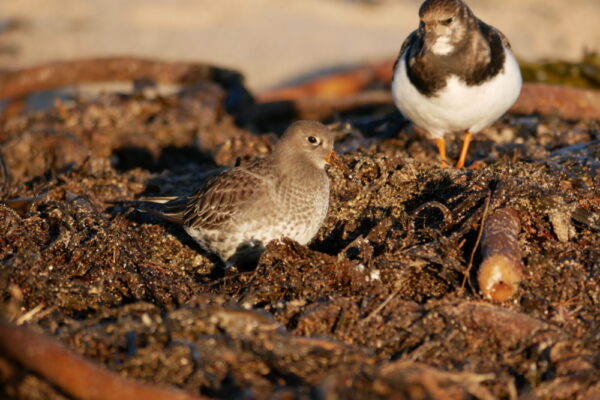Flying thousands of miles to raise young on our shores
As the days get longer and spring approaches, the extra hours of daylight signal to many species that it is time for some seasonal behavioural changes. For most wildlife, spring heralds their breeding season, when they make the most of the warmer temperatures and extra daylight to produce the next generation.

Purple Sandpiper and Turnstone
Many of the shorebirds seen on the Northumberland coast over winter push this seasonal behaviour even further by undertaking incredible feats of migration. These tenacious birds can fly thousands of miles to reach their breeding grounds, where the habitat is better suited to raising their young and giving their chicks the best possible chance of survival.
Around April each year our Purple Sandpipers set off on a journey of up to 2,000 miles that will take them as far north as Svalbard, deep inside the Arctic Circle. Their chicks, once hatched, can run around and feed themselves within a couple of hours and during their summer when the sun never sets, they get 24 hours of daylight to cram in as much feeding as possible and within one month they are ready to fledge.Flying thousands of miles to raise young on our shores
When young birds first undertakes migration, they are driven purely by instinct, but if they succeed, they can learn from experience and memorise their route. This allows them to revisit the best stop-over locations to rest and refuel, as well as learning about the best winter-feeding grounds.
For Purple Sandpipers to stand a chance of making it through this huge journey and arriving in the Arctic with enough energy to raise a family, it is important that they leave our shores in the best possible condition. This means that while they are here it is important for them to feed up as much as possible and to conserve calories so that they have enough energy for their flight. The good news is the Northumberland coast has excellent feeding opportunities for shorebirds. There is a fantastic mosaic of habitats along our shores, a mixture of muddy bays and estuaries, sandy beaches and gently sloping rock platforms that offer a wide variety of food sources.
Unfortunately, these birds can really struggle to get enough calories if they are disturbed by people using the beach. Flying away from a disturbance costs energy, particularly in freezing winter weather. Luckily, we can take some simple steps to reduce the disturbance we cause when enjoying the coast. Firstly, we can look for where the birds are on the shore and give them space, usually 40 – 50m will prevent disturbance. This might mean moving off the beach to the coastal path for a short stretch, particularly at high tide. This can make a real difference.
Secondly, our dogs love spending time on beaches too, but they can also cause disturbance if they get excited and want to chase the shorebirds. Big sandy expanses of beach are used less than rocky and muddy areas by shorebirds at this time of year, so they are wonderful places to let dogs run and let off steam while keeping bird disturbance to a minimum.
For more information on how you can make a difference visit spaceforshorebirds.co.uk or follow us on social media. We also run guided walks and birdwatching events throughout the year along the Northumberland coast. You can sign up for these for free on our website, so why not come along and see what you can spot?\
Thank you for giving space for shorebirds.
Ben Arthur
Space for Shorebirds












